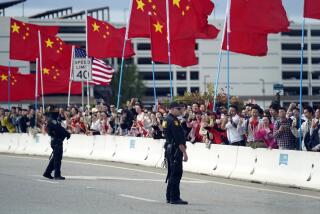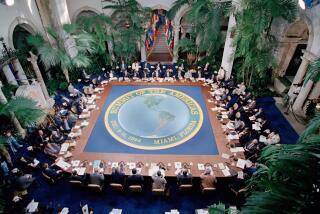Trade Forum’s Saving Grace
The 21-nation Asia Pacific Economic Cooperation forum (APEC) started out in 1989 as an organization that would lead its member governments to open markets and economic integration. In 1994, under President Clinton’s leadership, it agreed to convert to a free-trade area that would unite half of the world’s population, 60% of the global output and nearly half of the trade. When Clinton makes his valedictory appearance at the APEC summit in Brunei today, he will find the group no closer to its goal than it was six years ago. Asian integration is taking place elsewhere, in bilateral agreements and smaller subregional groupings.
Criticism of APEC as a do-nothing organization is largely justified, at least if its accomplishments are measured against the ambitious goals it set for itself. The biggest was to create a free market among its more developed countries by 2010 and the rest by 2020. At the 1997 summit, the APEC leaders got more specific and decided to slash import tariffs on $1.5 trillion in goods. A year later, with many of the Asian countries struggling with the worst financial crisis since World War II, APEC was in disarray and the tariff cuts were all but forgotten. The summit dissolved in acrimony, with the East blaming Western profiteers and the West complaining of corrupt Asian governments. Vice President Al Gore, deputized by Clinton, added fuel to the fire by delivering a patronizing speech that very nearly called for the ouster of Malaysian Premier Mahathir Mohamad.
Since then, Asia has weathered its economic crisis and tempers have cooled. This will assure a more peaceful summit in Brunei, but little else. Clinton will be saying his farewells, Canadian Prime Minister Jean Chretien, who is facing an election, won’t show up and Japan’s beleaguered Prime Minister Yoshiro Mori faces ouster by his own party.
Asian integration is taking place elsewhere, in trade deals negotiated by Japan, South Korea and Singapore, and among smaller subregional groupings. China, the trading powerhouse of Asia, will play an increasingly active role in its neighborhood once it enters the World Trade Organization.
But, while disappointing as the vehicle for trade liberalization, APEC has served well as a forum in which countries on both sides of the Pacific can discuss political, security and economic issues. They give U.S. presidents, current and future, the opportunity to meet their Asian counterparts face to face. APEC is unlikely to agree on the agenda for the next round of world trade liberalization talks--it is too diverse for that. But it is the best place for the West and Asia to talk to one another.
More to Read
Sign up for Essential California
The most important California stories and recommendations in your inbox every morning.
You may occasionally receive promotional content from the Los Angeles Times.










